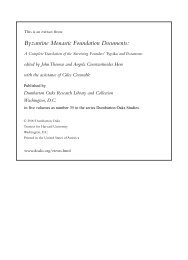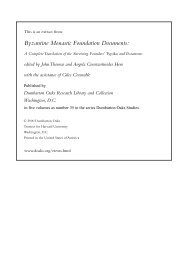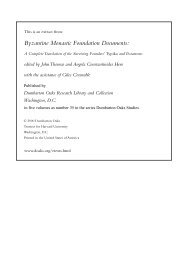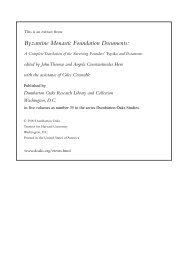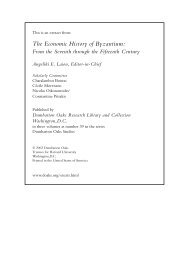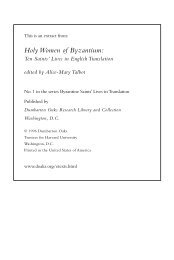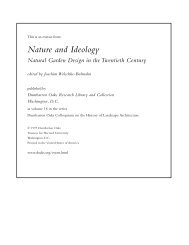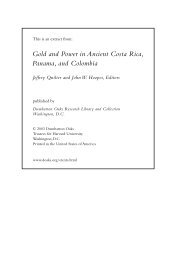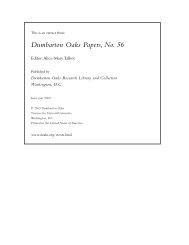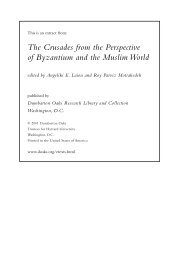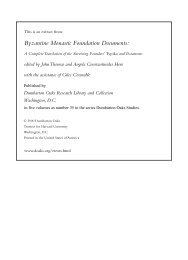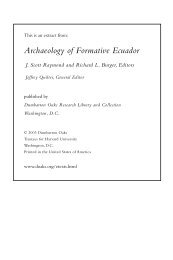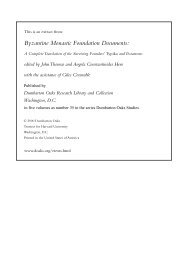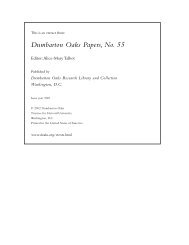Download: Mosaics of Hagia Sophia, Istanbul - Dumbarton Oaks
Download: Mosaics of Hagia Sophia, Istanbul - Dumbarton Oaks
Download: Mosaics of Hagia Sophia, Istanbul - Dumbarton Oaks
You also want an ePaper? Increase the reach of your titles
YUMPU automatically turns print PDFs into web optimized ePapers that Google loves.
tached tesserae were reset by gluing them to a cloth, and<br />
after consolidation <strong>of</strong> the plaster the mosaic was reinstalled.<br />
A temporary wooden strut was then fixed over the<br />
repair in order to push the mosaic tesserae and new<br />
plaster back into position against the wall. This procedure,<br />
a new one, preserved the original mosaic by<br />
strengthening its connection with the plaster and the<br />
bricks <strong>of</strong> the wall (Figs. 43-46). The conservators were<br />
particularly concerned about the condition <strong>of</strong> the bricks<br />
just behind the plaster under the mosaic <strong>of</strong> the Virgin<br />
enthroned with Christ child in the apse (Figs. 47-50). 37<br />
Permission was obtained from the Turkish government to<br />
remove the lead from the exterior <strong>of</strong> the apse. Comparison<br />
<strong>of</strong> the bricks there to other (sixth-century) bricks in<br />
the building revealed that the apse conch brickwork is <strong>of</strong><br />
that time period, and therefore precedes the mosaics<br />
there, which are <strong>of</strong> the ninth century.<br />
44<br />
Cleaning the <strong>Mosaics</strong><br />
The conservators’ fieldwork records indicate<br />
considerable experimentation with new tools and with<br />
new chemical solutions for cleaning the mosaics and for<br />
the plaster used in consolidating the tesserae. Dental<br />
instruments, which are basic tools in conservation today,<br />
were first tested in <strong>Hagia</strong> <strong>Sophia</strong> in 1934 and found to be<br />
satisfactory for the work there (Figs. 51, 52). Originally,<br />
the method for cleaning plaster-encrusted mosaics called<br />
for scraping the surface with a sharp steel chisel, chopping<br />
away the final layer <strong>of</strong> plaster over the tesserae with a<br />
chisel, and then polishing the surface with brushes. It was<br />
a very slow and laborious process, as each tessera had to<br />
be cleaned individually (Fig. 53; Pl. 3). While working on<br />
the s<strong>of</strong>fit <strong>of</strong> one <strong>of</strong> the arches in the central bay <strong>of</strong> the<br />
south gallery in 1937, the conservators experimented with<br />
37 W. J. Gregory, observation book, 1934.<br />
45<br />
Specimen <strong>of</strong> a cramp used by<br />
Byzantine Institute conservators<br />
to consolidate the mosaics<br />
(photo: P. Iskender, Byzantine<br />
Institute, ca. 1933)




